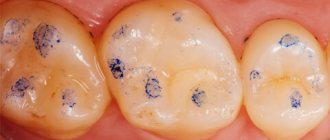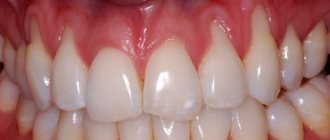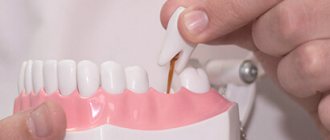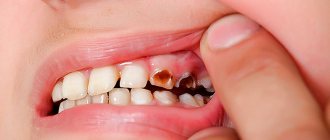According to statistics, the 6th tooth implant is installed more often than others, which is due to the characteristics of this first molar. Sixes are the first of all permanent teeth to erupt, they are used more, and therefore deteriorate faster and more often than others. The procedure for implantation above and below differs in the choice of implant and timing of prosthetics. Implantation of a six on the upper jaw takes longer - 4-6 months, on the lower jaw - 2-4 months. Osseointegration occurs with differences due to the structural features of the jaws and different bone densities. The total duration of treatment depends on the volume of bone tissue; if there is a deficiency, bone grafting or sinus lifting is performed first.
Why do sixth teeth deteriorate more often than others?
The sixth teeth (first molars according to dental classification) are molars. The rudiments are laid at the 5th month of fetal development, and at the 9th month their mineralization occurs, which continues throughout the first month after the birth of the child. Their final formation with enamel occurs only by the age of 2-3 years. Therefore, the condition of the root and crown depends on the course of pregnancy and childbirth.
Sixes do not erupt in early childhood, since the function of chewing is not yet needed. When they erupt, they do not have predecessors in the form of milk teeth, so they essentially grow from scratch. Of the permanent molars, they begin to erupt first at 5-6 years, so they last longer than others. Frequent diseases, removals and the need for implants are associated with this.
How many canals are there in teeth?
The number of tooth canals does not always coincide with the number of roots. The number of channels can only be determined using x-rays. The upper incisors usually have two or three canals. Some teeth have only one canal, which branches into two parts.
Number of canals in teeth:
- Upper Lower four – 1, less often 2 channels;
- Upper second – 1, less often 2 and even 3 channels;
- Bottom five – one channel;
- Upper first molar 3, 4 canals;
- Lower first molar – 3, less often 2 canals;
- Upper and lower seven – 3, 4 channels.
Is it worth getting an implant?
The absence of the sixth tooth threatens:
- displacement of neighboring units;
- advancement of antagonists on the opposite jaw.
Neighboring and antagonist teeth will slowly shift, which threatens to expose the roots, the appearance of wedge-shaped defects at the gum itself, exposure of the neck, which is sensitive to changes in temperature of water and food, and pain. In addition, there will be a change in the bite, since the teeth will be out of place. Therefore, it is necessary to place an implant to maintain healthy teeth and correct bite.
Classifications of teeth
To begin with, it is worth clarifying the terminology, since many people understand the word molars to be permanent teeth. Although these are concepts from different classifications.
The following types of teeth are distinguished:
- incisors
ー these are the front teeth (“ones” and “twos”), they have a sharp edge and are used for biting off pieces of food; - fangs
ー conical teeth used for tearing dense food; - small molars
(premolars) - these are “fours” and “fives” in the dentition; - large molars
- sixes, sevens and eights. Large teeth with a wide chewing surface serve, like premolars, for grinding food.
That is, these teeth can also be milk teeth, but with their own characteristics - in children, in the milk bite, only the first and second molars are distinguished from the chewing ones. And it is with molars that problems arise - how to determine whether a child has milk or permanent teeth?
Operation stages
The six implant is installed in the classical way, as for all other lost teeth. Includes stages:
Preparation
Identification of contraindications, assessment of bone tissue and study of its size and density. Sanitation of the oral cavity, removal of plaque, treatment of gums and adjacent teeth. The stage lasts from several days to a month.
Bone tissue augmentation
If necessary, it is carried out as a preliminary stage in case of lack of bone tissue. The operation lasts an hour. After the planted material has fused with the bone (4-5 months), the artificial roots themselves are installed.
Installation of implants
The gum is peeled off, a bed is formed in the bone, an implant is placed, a plug is fixed, and sutures are applied. On the lower jaw, the implant takes 2-4 months to take root, on the upper jaw - 4-6 months.
Temporary prosthetics
At the patient’s request, lightweight plastic removable Butterfly immediate dentures are installed, which are attached to adjacent teeth.
Permanent prosthetics
The implant is opened, the plug is removed, the gum former is fixed, and after 10-14 days the abutment is installed. Impressions are taken and crowns are installed.
The sixth tooth implant can be placed immediately after removal into the resulting socket, but with a sufficient amount of bone tissue and under the following conditions:
- a pre-planned operation with the possibility of conducting diagnostics and assessing the immediate installation of an implant;
- atraumatic removal without damaging the alveolar process;
- absence of inflammatory and purulent processes at the root.
Crown for a chewing tooth
The main purpose of a crown for the sixth tooth is to restore chewing function. The crown must be made of durable material to withstand heavy loads. Let's look at the types of crowns that are installed on chewing teeth.
Metal-ceramic crowns. Due to the durable metal frame and external ceramic lining, the tooth is firmly held in the oral cavity. But there are also disadvantages: over time, the metal frame begins to show through the gums. The crown itself does not have light transmission properties and can stand out against the background of natural teeth.
Zirconium dioxide crowns have all the properties of natural teeth. The main feature is the ability to transmit light. This makes them indistinguishable from a real tooth. These crowns are considered the best today. They last a long time and do not cause allergic reactions.
Metal crowns. The most budget option, but very unaesthetic. When you smile, others can easily notice your artificial tooth. In addition, metal crowns are gradually becoming a thing of the past, giving way to more modern materials.
Only a doctor can give an exact answer to the question of which crown to put on a chewing tooth after a detailed study of the clinical case.
Features of implantation of the 6th lower tooth
The six of the lower jaw bears more loads during chewing than the upper jaw. Therefore, implants are selected taking this fact into account - wide and of sufficient length. The nuances of implantation from below:
- easier to carry out than on the top;
- implants take root faster - in 2-4 months, since the jawbone is denser and anatomically higher;
- but there is a risk of damage to the trigeminal nerve if the protocol is not followed, which is complicated by numbness of the chin and lips.
If the bone is small in height, then a preliminary operation is performed to increase it. The gum is peeled off, bone material is added, and a resorbable membrane is applied to secure it. Recovery takes up to six months.
Without preliminary bone grafting, surgery is possible if the atrophy is moderate. In this case, our Center uses bone growth stimulants. They are fixed to the neck of the artificial root during its installation and trigger the processes of bone tissue regeneration. In this case, implant healing and bone tissue growth occur simultaneously.
Indications and contraindications for molar tooth extraction
Reasons for removing a molar tooth may be:
- purulent periostitis;
- abscess;
- phlegmon;
- large tumor in the tooth area;
- purulent periodontal disease;
- the presence of a cyst in the area of the diseased tooth;
- exposed pulp;
- longitudinal tooth fracture;
- critical tooth decay;
- critical tooth curvature;
- disease of the dental bone tissue;
- sinusitis.
The following reasons are contraindications to the removal of molars:
- acute heart diseases;
- acute viral diseases;
- flu;
- angina;
- renal failure;
- pancreatitis;
- hepatitis;
- acute diseases of the nervous system;
- oncological diseases
- initial and final stages of pregnancy;
- stomatitis;
- gingivitis
- general degeneration of the body;
- alcohol poisoning.
Price
Our Center has a case payment system, which means that the case includes all materials and necessary manipulations.
The cost of implant installation includes:
- implant and superstructures;
- work of an implantologist;
- anesthesia;
- basic bone building complex;
- primary and repeat CT.
The price of implants varies depending on the type of bone. Nobel Biocare PMC (cheaper) is intended for weak tissue, and Nobel Biocare Conical Parallel CC (more expensive) is intended for dense tissue.
The cost of the crown includes:
- production of a prosthesis by a technician;
- taking impressions;
- installation of a crown.
Tooth extraction (for simultaneous implantation), bone grafting or sinus lifting are paid separately. Prices for services can be found here.
How to care for a crown
The service life of crowns varies from 5 to 15 years, depending on the material and compliance with hygiene rules. Despite the fact that the crown is made of artificial material, plaque also accumulates on it. You should take care of it the same way you would take care of your teeth. Particular attention should be paid to the area at the edge of the gum. Dental plaque in these places can cause inflammation and other problems in the body.
Basic recommendations for crown care
- Brushing teeth 2 times a day
- Use of additional hygiene products: brush, dental floss, irrigator.
- Professional teeth cleaning every six months. If the dentist indicates other dates, follow his recommendations.
- Preventative visits to the dentist every six months.
- Monitor the condition of the joints between the tooth and the crown.
- Do not eat cold and hot food at the same time.
If you experience crown mobility, an unpleasant taste, or any other discomfort in the oral cavity, you should make an appointment with your doctor. Otherwise, it can lead to serious complications. You can get to our doctors by calling: 220-86-30
Guarantees
In our Center, implants are installed with a lifetime warranty from the manufacturer - Nobel Biocare. We provide guarantees:
- lifetime for the installation of implants;
- 1 year for crowns.
The warranty program includes a complex for the implant, surgery, bone reconstruction and prosthetics.
The guarantee is valid provided that the patient follows the doctor’s recommendations, care rules and regularly visits the dentist.
Number of roots and canals
The human mouth contains special organs – teeth. They are endowed with a specific shape and structure. They are systematized into dairy and indigenous ones. There are 20 milky ones, 32 indigenous ones. In the rarest cases, organs appear beyond the set.
Any unit contains a crown, root and neck. The chewing organs are endowed with 2 and 3 roots with canals. On top of the crown there is enamel, which protects the masticatory organs from injury and is considered a durable tissue (A collection of different and interacting tissues form organs)
human body.
Under the enamel is porous and strong dentin. It surrounds the inside of the organ with a pulp containing blood vessels and a group of nerves that enter here from holes in the bone. With the help of these holes of various sizes, the roots interact with the blood (the internal environment of the body)
and lymph.
All chewing organs have a personal configuration and system, among them there are unique ones called wisdom teeth. The number of roots in each unit is related to its position and purpose. With greater overload, the holding means will be stronger.
Alternatives
An alternative method for restoring sixes is a bridge prosthesis. This is a structure consisting of crowns tightly connected to each other. To restore one tooth, the bridge consists of 3 crowns. The two outer ones are fixed on the teeth on both sides of the defect. The supporting teeth are ground down to form the internal cavity of the outer crowns of the prosthesis. The middle crown is hinged and imitates the lost six.
This option is cheaper than implantation, but has disadvantages - grinding the enamel of living teeth leads to a reduction in their service life. Another important point is that the bone under the hinged crown does not receive stress during chewing, so bone tissue atrophy is inevitable.
Root canal treatment
The treatment plan for dental canals consists of several stages:
- First, access to the problem area is freed: using a special dental instrument, the filling or the area of the crown damaged by caries is removed.
- Then the contents of the pulp are removed, and the canals are cleaned mechanically using antiseptic drugs.
- After this, the root is prepared for filling. At this stage, the dentist can form the correct conical shape of the canal passage.
- Then the canals are carefully sealed. If baby teeth are treated, the dentist uses a special filling paste, which gradually dissolves as the root dissolves.
- After this, a filling is placed on the crown.
This treatment regimen is standard and does not depend on exactly how many canals there are in the diseased tooth. The main thing is that all dental canals are cleaned, treated with an antiseptic and carefully closed. If treated incorrectly, it may be necessary to remove the tooth and visit an oral surgeon.
Teeth can be single-channel, two-channel, three-channel and even eight-channel. If one of the ducts becomes inflamed, it is necessary to clean and seal not only it, but also all other canals, since the infection could penetrate into them.
How to remove a rotten tooth root while preserving the crown
A tooth in which only the root remains is not always pulled out entirely. For example, if an inflammatory process develops at the root apex, but the tooth itself can still be saved, resection of the root apex is performed - partial removal.
The procedure is carried out after filling the canals, under local anesthesia. The operation is simple and lasts no more than half an hour. Its main stages:
- Anamnesis collection.
- Preparation of the surgical field.
- Anesthesia.
- Cutting the gum to access the root.
- Delamination of soft tissues.
- Sawing out a “window” in the bone.
- Cutting off the inflamed area of the root with a granuloma or cyst.
- Placing drugs into the cavity that stimulate bone growth.
- Stitching.










